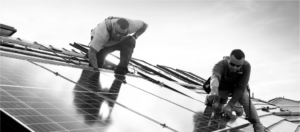How “stationary” and “mobile” inverter systems differ
OutBack Power, Magnum Energy, and others make inverters designed for “mobile” applications. Mobile inverters are basically the same as the stationary off-grid inverter models, but they differ in how the AC power outputs are connected to ground.
NEC Grounding
The National Electrical Code (NEC) requires that AC electrical systems have one of the current carrying conductors (power wires) connected to the grounding system. Typically, this would be the “neutral” conductor connected to ground in an AC system, and is called “neutral bonding”.
In a Code-compliant AC electrical system, the AC neutral is connected to the grounding system at one point, and only one point, in the wiring system. [See Sidebar: NEC Grounding] Bonding the neutral and ground conductors together can only occur at one point in the system because if they are bonded at two points, then the ground wire essentially becomes a parallel neutral conductor and current (amps) flowing through the conductors will be divided between, and travel through, both the neutral conductor and the grounding conductor under normal operating conditions. Current flowing through the grounding system is unsafe, and is not allowed by the Code, except during “fault” conditions.
If the neutral and grounding conductors are bonded at only one point, it does not create a circuit, and no current will flow through the grounding conductor unless an additional connection between neutral and ground occurs in a fault situation (for instance, damaged wire insulation causing the wire to touch a metal enclosure).
In a grid-connected building, this neutral bonding will be found in the “Utility Service Entrance” panel where the grid is first connected to the building. Typically, the Service Entrance also contains the circuit breakers for the individual building’s electrical circuits, although sometimes the Service Entrance only contains the utility meter and a main breaker, and the individual circuit breakers are located elsewhere in the building in a “sub-panel” (the sub-panel would not have a second neutral bond in it).
In an off-grid building, or other stationary off-grid power system, this AC neutral bonding is usually located in the inverter power panel. The power panel is the off-grid equivalent of the Service Entrance, since the inverter is the power source (instead of the grid), so this would be where a building inspector expect to find the neutral bond.
Mobile applications, like recreational vehicles (RVs) or boats, present an unusual application where bonding is concerned. Most mobile power systems operate completely off-grid some of the time, but are also sometimes connected to the grid. For instance, you might park an RV in a campsite that doesn’t have a power hookup for RVs, and where you will be using the inverter/battery system to provide AC power. At other times, the RV may have utility power hookups.
If the RV is not connected to the grid, there needs to be a neutral bond in the RV’s power panel. If the RV is connected to a grid hook-up at an RV park, the utility power system in the RV park will already have a neutral bond in the Service Entrance, so the bond in the RV needs to be disconnected. Otherwise there would be two bonds, which as explained earlier, presents an unsafe condition.
To address this problem, inverters designed for mobile applications have provisions for internal bond switching. A set of relays are used to connect AC neutral to ground when the system is not connected to an external power source, and the relays will disconnect the neutral from ground if the system is connected to an external power source (grid or generator).
Below are a couple of diagrams from the Magnum ME installation manual showing how Magnum ME inverters use relays for ground switching (“standby mode” means that the inverter is connected to an external power source). OutBack uses a similar strategy with their mobile inverters:
*Figures included with permission from Magnum Energy Inc.
Inverters are tested to different UL standards depending on whether they are intended for stationary or mobile use. Each inverter model should only be used for the applications that they are designed for and UL Listed for.
UL 458 is for “Mobile” applications and requires that the inverter have “ground switching”.
UL 1741 inverters do not have a neutral/ground internal bond. The bonding should occur in the inverter power panel or AC load center (or in the case of a grid-tie system, in the Utility Service Entrance).
Some inverters, such as the Magnum MS2012, MS2812, and MS4024, are Listed to both UL 458 and UL 1741. This means that the inverter has a built-in bonding relay, but it can be defeated by disconnecting a ground wire in the inverter’s AC wiring terminal box.
Inverters Listed only to UL 458 should only be used in mobile applications, not residential or commercial stationary off-grid systems.
Inverters Listed only to UL 1741 should only be used for residential and commercial stationary off-grid applications, not in vehicles or other mobile applications.
Inverters Listed under both UL 458 and UL 1741 can be used for either application. However, off-grid installers need to carefully read the installation manual to ensure that grounding and bonding are correctly set up before operating the system.

